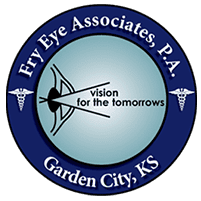Dry Eye & Blepharitis
The symptoms of dry eye and blepharitis affect a tremendous number of people in the United States. In milder cases symptoms like eye irritation, pain and transient blurry vision are common, while serious cases can lead to damage to the eye and persistently decreased vision. The experienced doctors at Fry Eye Associates offer comprehensive treatment plans to increase your quality of life and reduce the risk of damaging your eyes.
Learn More

Dry Eye & Blepharitis FAQ
The surface of your eye is protected and maintained by a complex film of tears that itself has three layers (a mucous, tear, and oil layer). Every time you blink the tear film replenishes the eye surface and flushes out irritants.
When this tear film isn’t working correctly the result is dry eye, a syndrome that leaves your eyes feeling irritated and often results in blurry vision that comes and goes. Other potential symptoms include burning, scratchiness, redness, increased light sensitivity, increased tearing and eyelid crusting. There are several types of dry eye, though often the type of dry eye is related to the layer of the tear film that is most depleted (mucous, tear or oil layer).
Dry eye can be associated with:
- Age
- Various eyelid disorders like ectropion or floppy eyelid syndrome
- Blepharitis (see below)
- Environmental conditions
- Rheumatoid arthritis and other chronic inflammatory diseases
- Medications such as antidepressants or anti-allergy drugs like diphenhydramine (Benadryl)
While there is no cure for dry eye, the Fry Eye Associates doctors will create a treatment plan that is tailored to each individual patient based on the type and severity of their dry eye, with the goal being to increase comfort, improve vision and protect the eyes from unnecessary damage.
The team offers several solutions for dry eye including:
- Artificial tears
- Restasis® and other anti-inflammatory eyedrops
- Punctal plugs – small plugs that are placed into your tear ducts to prevent tears from draining away too quickly
- Bruder masks and other forms of thermal therapy for meibomian gland treatment
- Serum tears – tears made from your own blood that can be effective in severe cases
After a comprehensive eye exam and dry eye diagnostic testing, your Fry Eye Associates doctor develops your treatment to meet your needs. They monitor your condition to ensure your symptoms are significantly reduced or resolved and that your eyes remain healthy.
Blepharitis is the medical term for inflammation of the eyelid margins, which is the part of the eyelid where your eyelashes and oil-secreting glands are found. It’s a common condition that can affect people of all ages and can be a significant source of irritation. Dysfunctional oil glands (called meibomian glands), rosacea, overgrowth of certain naturally-occurring bacteria or Demodex mites are common sources of blepharitis and your body reacts with an inflammatory response that causes the uncomfortable symptoms.
Some of the symptoms of blepharitis include:
- Red eyes
- Flaking or greasy skin around your eyes
- Watery eyes
- Crusted sticky eyelashes in the morning
- Itchy or swollen eyelids
- Sensitivity to light
- Abnormal eyelash growth or loss
- Having styes or chalazions
- Dry eye
Most people with blepharitis notice more than one of these symptoms. If you detect these changes, consider a diagnostic exam at Fry Eye Associates.
While there is no cure for blepharitis, the Fry Eye Associates doctors can examine your eyes and recommend treatment based on the type and severity of the condition.
An important component of blepharitis treatment is keeping the eyelid margins free of debris and keeping the oil glands from becoming blocked. Using warm compresses, gentle eyelid message and eyelid margin cleaning with over-the-counter eyelid-cleaning products or baby shampoo is an excellent way to achieve this. Bruder moist heat eye masks and other forms of thermal therapy are offered at Fry Eye Associates to help improve the flow of the dysfunctional oil glands and provide dry eye relief.
In cases where excessive bacteria is present or your condition is related to issues like rosacea, then you may need to complete a course of oral or topical antibiotics as part of your treatment plan. In other cases, prescription anti-inflammatory eyedrops can be very helpful.
At dry eye evaluation, your doctor will discuss all available treatment options and help you chart a course that aligns with your needs and lifestyle.
Schedule Your Visit
Our doctors are here to help address your concerns about your eyes and are experts in finding solutions that work best for you.


